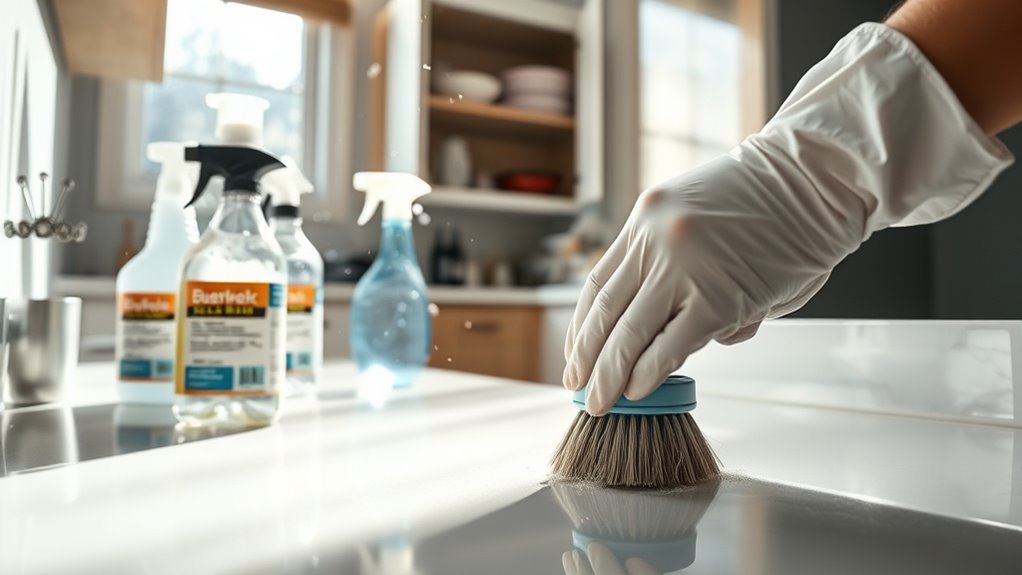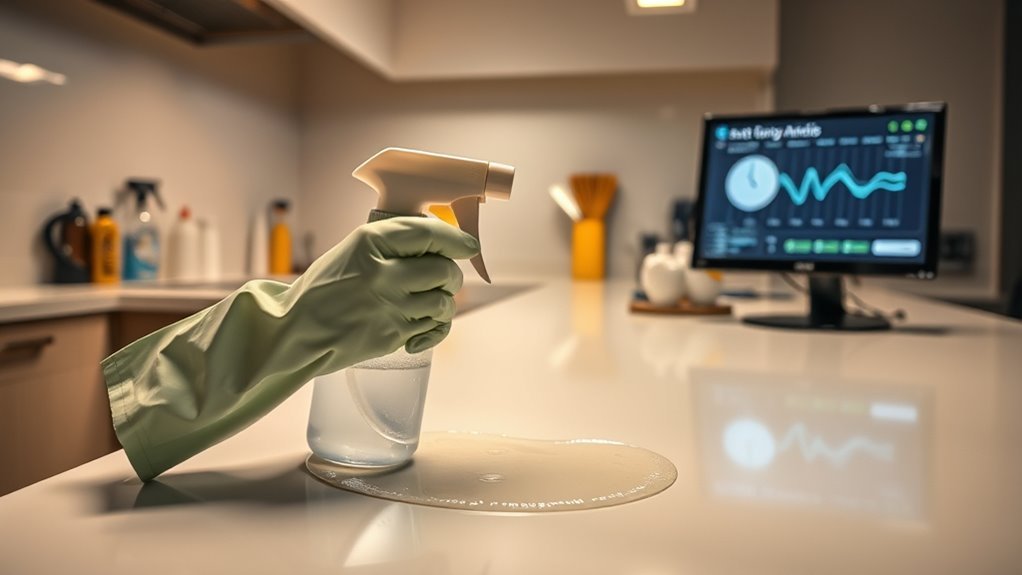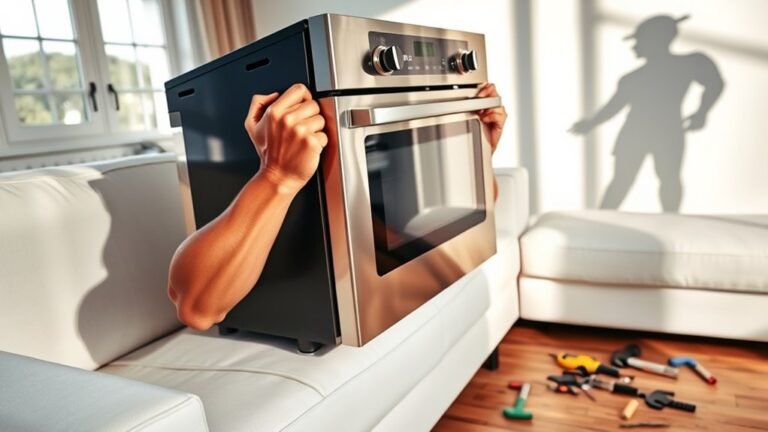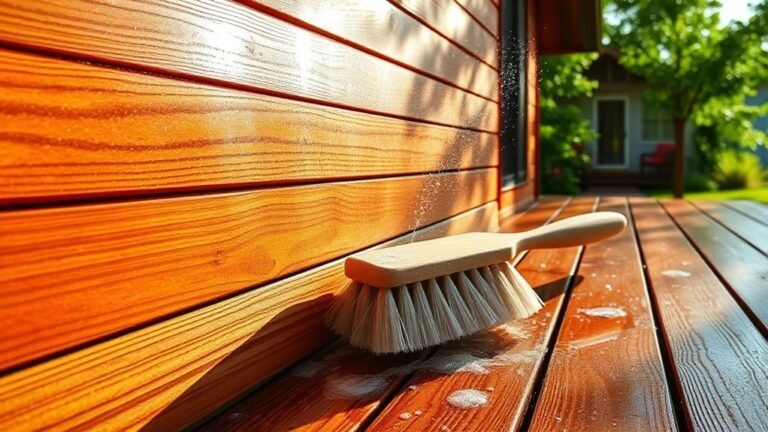Cleaning and Sanitizing After a Pest Infestation
After a pest infestation, you’ll want to first assess the damage and identify all affected areas. Always wear gloves and a mask to safely remove droppings and contaminated materials, avoiding dry sweeping to prevent spreading germs. Deep clean surfaces, including hidden spots, using natural disinfectants like vinegar for safety. Seal cracks and keep your space clutter-free to prevent future problems. Keep following these steps to regain full control and a healthy environment.
Assessing the Extent of the Infestation and Damage

Before you begin cleaning, you need to assess how severe the infestation is and what damage it caused. You’ll want to carefully look for infestation signs like droppings, gnaw marks, nests, or odors. These clues help you understand where pests have been active and how widespread the problem is. Conducting a thorough damage assessment lets you determine which areas need the most attention and whether structural repairs are necessary. By pinpointing the extent of the infestation and damage, you gain control over the situation instead of feeling overwhelmed. This step is vital—it sets the stage for effective cleaning and restoration, giving you the freedom to reclaim your space with confidence and clarity. Don’t rush it; a solid damage assessment guarantees you’re tackling the root of the problem.
Removing Pest Droppings and Contaminated Materials
Once you’ve identified the affected areas, you’ll need to carefully remove all pest droppings and contaminated materials to prevent health risks and further infestation. This step is essential for effective pest removal and safeguarding your space. Here’s how to tackle it:
Carefully remove all pest droppings and contaminated materials to prevent health risks and stop further infestation.
- Wear gloves and a mask to protect yourself from harmful pathogens.
- Use disposable cloths or paper towels soaked in a disinfectant to wipe up droppings—avoid sweeping or vacuuming dry droppings, as it can spread contaminants.
- Dispose of all contaminated materials, including nesting debris and damaged items, in sealed bags to prevent pests from returning.
Taking these precautions guarantees you minimize health risks and regain control over your environment, giving you the freedom to enjoy a clean, safe space.
Deep Cleaning Surfaces and Hard-to-Reach Areas

Although removing droppings and debris is essential, deep cleaning all surfaces and hard-to-reach areas guarantees that any lingering contaminants and pest residues are completely eliminated. You’ll want to use the right cleaning tools tailored to different surface types—wood, tile, and metal each require specific care. Don’t forget those hidden corners and vents where pests love to hide; thorough attention there restores your space’s freedom and safety.
| Area | Surface Type | Cleaning Tools |
|---|---|---|
| Kitchen counters | Granite | Microfiber cloth |
| Air vents | Metal | Small brush |
| Behind appliances | Tile | Vacuum with crevice |
This focused cleaning empowers you to reclaim your home, ensuring every inch feels fresh and secure.
Proper Disinfection Techniques and Safe Cleaning Products
When tackling post-infestation cleanup, you’ll need to focus on proper disinfection techniques to guarantee harmful pathogens are eliminated without risking your health. Opt for natural disinfectants and eco friendly cleaners to keep your space safe and chemical-free. These options protect your freedom to live in a toxin-free environment while effectively sanitizing.
Here’s how you can do it right:
- Use vinegar or hydrogen peroxide as natural disinfectants on hard surfaces.
- Choose plant-based, biodegradable eco friendly cleaners for soft surfaces and fabrics.
- Always ventilate rooms thoroughly to reduce inhalation risks during cleaning.
Preventing Future Infestations Through Maintenance and Monitoring

Since cleaning up after pests is only half the battle, preventing future infestations requires consistent maintenance and careful monitoring. You’ve earned your freedom from pests, so don’t let them sneak back in. Start with pest prevention by sealing cracks, fixing leaks, and keeping your space clutter-free. Regularly dispose of garbage and store food properly to eliminate attractants.
Incorporate routine inspections into your schedule, checking vulnerable areas like basements, kitchens, and attics. Look for signs such as droppings, nests, or gnaw marks. By catching issues early, you can act before they escalate. Staying vigilant means you maintain control and protect your environment without relying heavily on chemicals. Remember, your freedom from pests depends on proactive upkeep and smart monitoring—don’t wait for another infestation to take action.
Frequently Asked Questions
How Long Should I Stay Out of the Area After Cleaning?
When you’re wondering about the duration of evacuation after cleaning, it’s important to prioritize post cleaning safety. You’ll usually want to stay out for at least a few hours to let any cleaning agents or sanitizers settle and air out properly. This gives you peace of mind and the freedom to return without worrying about harmful residues. Always check product instructions, but generally, a short break guarantees a safer, fresher environment.
Can Pets Safely Re-Enter Immediately After Sanitizing?
Did you know that 70% of pet poisonings happen at home? When it comes to pet safety after pest control, you shouldn’t let your pets back in immediately after sanitizing. Chemicals used can be harmful, so it’s best to wait until the area is completely dry and ventilated—usually a few hours. This way, you keep your furry friends safe while enjoying the freedom of a pest-free home without worry.
What Personal Protective Equipment Should I Wear During Cleaning?
When you’re gearing up for cleaning, you’ll want to choose the right glove types, like nitrile or rubber gloves, to protect your skin from harsh chemicals and contaminants. For your face, mask options include disposable surgical masks or reusable respirators, depending on the job’s intensity. Wearing these lets you stay safe while giving you the freedom to tackle the task confidently without worrying about exposure or irritation.
Are Natural Cleaning Products Effective Against Pest Contamination?
Imagine you’re tackling a kitchen mess with just vinegar and baking soda, trusting natural alternatives. While these can help with light cleaning, their effectiveness comparison to commercial disinfectants shows they often fall short against tough pest contamination. You might enjoy freedom from harsh chemicals, but for serious infestations, stronger products usually work better. Still, combining natural options with thorough cleaning can give you a safer, balanced approach.
Should I Notify Local Health Authorities About the Infestation?
You should definitely consider notifying local health authorities if you’re dealing with a pest infestation. They’re there to guarantee health regulations are followed and can provide guidance or support for proper pest control. Reporting helps protect your community and keeps things transparent. While you want the freedom to manage your space, involving authorities can prevent bigger issues and assure everyone stays safe and healthy in the long run.






